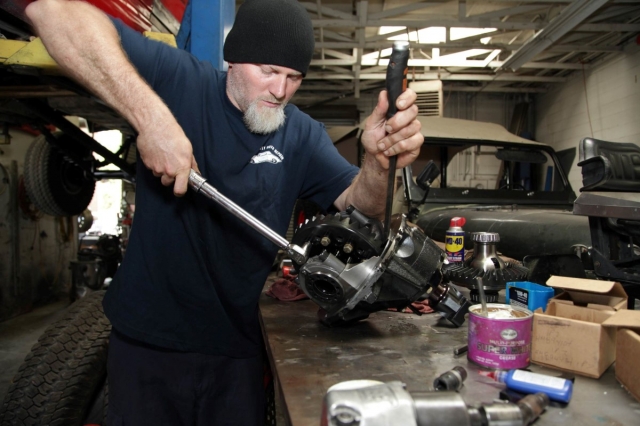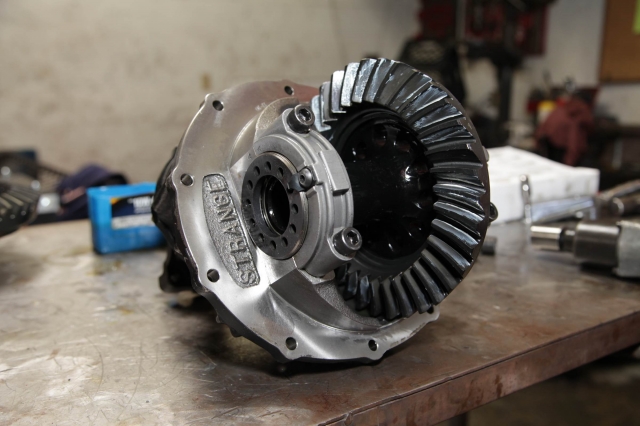
Our Project Biting the Bullitt 1965 Mustang is one of the more ambitious projects we’ve undertaken here at StangTV. It uses a serious combination in an attempt to push the bounds of streetability in a package that can be taken to the race track at any time.
At this point we’ve taken what was once a basket case of a car and turned into a legit 9-second warrior on low boost. But those upgrades have found us in search of even better elapsed times, and as we’ve recently added five more pounds of boost resulting in over 100 additional rear-wheel horsepower. The decision was made to upgrade the existing Strange Engineering nine-inch rearend in search of bulletproof consistency and reliability. We also need to optimize the gear ratio for the additional horsepower. To do so, we turned to the team at Motive Gear to assist us in achieving our goals.
Left - Motive's 3.50 9-inch Pro gears will give us extra durability along with the correct gear ratio to get through the traps. Right - We also chose a spool for this application as it is much less susceptible to breakage in high-horsepower situations.
The car relies on a Dart Iron Eagle-based 427 cubic-inch engine that uses Dart Pro 1 cylinder heads and is boosted by a Paxton NOVI-2500 supercharger that’s now making 16 pounds of boost. We’ve got a TCI Super Streetfighter 4L80E transmission on board feeding the power back to the Strange rearend. The suspension has been optimized for drag racing through the use of one of Total Cost Involved‘s custom independent front suspension systems and Calvert Racing‘s leaf springs and rear suspension. Wilwood brakes are at all four corners.
Pro Gear Versus Street Gear
There is one simple difference between a street gear and a Pro Gear set. Motive’s Street gears are machined from heat-treated 8620 steel, which is designed to hold up to the rigors of street use and is a very hard material that will stand up to the heat produced by a typical street car driving lots of miles. A Pro Gear set, on the other hand, is machined from 9310 steel.
“There are no set horsepower or torque ratings on a Pro versus a Street gear, although some people will say 1000 hp, or an eight or nine second quarter mile. A good rule of thumb would be if the vehicle is street legal and street driven, more than to and from the track, use an 8620 gear,” says Linville.
More Power = Less Gear?
Adding the additional power to the car wasn’t a problem, as the NOVI-2500-boosted powerplant has been rock-solid during our time together. One thing we’ve learned from our track outings, however, is that we’re past the point of no return with our current 3.70:1 gearset – we’re just running out of gear at the end of the track.
The fix for that is simple – a set of brand-spankin’ new gears from Motive Gear for our nine-inch housing.
The new gear ratio will allow us to bring the RPM level down just a bit at the end of the track. This will maximize our use of the engine’s powerband, allowing us to make use of all of the power our supercharged 427 makes.
Motive Gear Part Number F990350SP uses a 3.50 ratio and is one of Motive’s Pro Gear sets. What’s a Pro Gear, you ask? Check out the sidebar to the right to find out the differences between the two.
“Pro Gears, or 9310 gears, are designed for high horsepower, high impact drag racing applications. 9310 Pro gears are manufactured using different materials that the standard 8620 street gear, including nickel, and these gears are not designed to be driven daily on the street,” explains Motive Gear’s Bob Linville.
Left - On the right is the Detroit Locker we've removed from BTB, on the left is the new spool and gear assembly. The Locker worked perfectly at 720 rwhp and we had no issues with it. You can see the difference in mass - we're pulling out quite a bit of rotating weight in this upgrade. Middle - A press is used in the disassembly and reassembly process. Right - We needed to disassemble the old pinion gear assembly to measure the shims to get a baseline for setting up the new package.
Differential Versus Spool
Up until now, the car has had a Detroit Locker differential on board, which has been rock-solid, but we’re approaching the range where its durability might be called into question due to our escalating power levels and heavy weight. In our 3,200-plus pound car, getting all of the power and torque to the ground without breaking things can be considered a feat in itself.
There are two different designs that can be used to transmit torque from the driveshaft to the rear wheels – a differential, and a spool.
Left - Once the old shims are removed from the pinion gear, they are measured and set onto a piece of paper to keep track of each one. Right - Shims are stacked together at a total of .052-inch to achieve the correct backlash of .015-inch.
A differential is designed to have three jobs. The first job is to take the engine power and transmit it to the drive wheels. The second job is to act as the last gear reduction in the vehicle, slowing the rotational speed of the driveshaft one last time before it gets to the wheels, and the third job is to transmit that power while allowing the wheels to rotate at different speeds – and it’s this third job that’s given the differential its name. Why do the wheels need to rotate at different speeds? In a true street-driven car, they need to do so in order to safely navigate a turn.
As a car goes around a corner, each wheel travels a different distance; the outer wheel has more rotations while the inner wheel travels a shorter distance. As a result of this speed differential, the inner wheel also travels at a slower speed.
A good rule of thumb would be if the vehicle is street legal and street driven, more than to and from the track, use an 8620 gear. – Bob Linville, Motive Gear
Non-drive wheels (in our case the front) are not linked together, so for those wheels this difference in speeds is not an issue. But the drive wheels are linked together, and in order to do that, there are gears within the differential housing that permit the components to operate properly. The differential splits the engine torque in two ways, which allows each output to spin at a different speed.
The upside to this is that a differential equipped car doesn’t skip and chatter around a corner, but the downside is that these components can only be built so strong before failure becomes a concern, especially in regards to straight-line performance.
That’s where the spool comes in. The spool does one job, and one job only – takes the engine’s power and transmits it to the drive wheels, in sync, and at one speed. It performs the job of locking the axles together to maximize power transmission, and in our case as we’re approaching the eight-second range, will give us the on-track durability we’re after.
Fluid Fill With Driven Lubricants
We’ve been using Joe Gibbs Driven oils with all of our projects lately, and Biting The Bullitt’s rearend assembly is no different. We used 3.5 quarts of their Racing Gear Oil 75W-110 synthetic fluid after the center section was bolted back in place and the driveshaft was snugged up.
The fluid is capable of reducing operating temperatures by up to 15 degrees Fahrenheit and has proven durability. It provides excellent shear stability and maintains its viscosity even after hours of running all-out, which is a trait we hope to never have to take advantage of, but it’s there if we need it. The fluid is engineered to provide excellent stability and reduce friction.
The full spool does not have any of the internal reduction gears that are present in a differential. In very simple terms it’s basically a piece of machined steel that has a mounting face for the ring gear and internal splines to drive the axles.
With these concepts in mind, we’ve picked out one of Motive’s full spools to install in the rearend. Part Number FS9-35LW is a 35-spline full spool that’s designed for our nine-inch Strange rearend housing, with one added attraction – it’s one of Motive’s Lightweight pieces that’s had some of the extra non-essential rotating weight machined out of the spool.
“In steel spools, there are quite a few different weight options available, and many different names for these,” says Linville. “A stock full steel spool will generally weigh between nine and nine-and-a-half pounds, while a lightweight steel spool will weigh approximately eight pounds. There are also Mega or Ultra lightweight steel spools that can weigh as little as six or seven pounds. Aluminum spools weighing as little as four-and-a-half to five pounds are also available, but are not recommended for certain racing applications. Spools are available up to 40 spline, to allow the use of larger, heavy duty axle shafts.”
The more rotating weight you have to turn in an effort to get down the track, the more performance will be hindered. Any place you can remove that weight without hurting durability will allow the part in question to accelerate more quickly, helping performance on the track.
Left - Prior to assembly of the pinion bearing stack, oil is applied to the bearings that ride inside the pinion support. Left Middle - The pinion and pinion support in the process of assembly. Right Middle - Installing the carrier bearings onto the new spool. Note that the ring gear has already been installed. Right - Once the whole package is together, backlash is checked using this dial indicator to achieve the previously established .015-inch. dimension. This prevents noise and will assure long life from our new gearset.
Conclusion
Since our last track visit, we’ve upgraded Biting The Bullitt with more power, more boost, new headers, and now a new gearset and spool that will help us to handle the additional power without fear of failure, or going through the traps at an RPM level that’s too high. Racing season is getting started soon, and we’ll have some fresh results for you just as soon as we can get to the track.

One final check of the torque on all of the retaining bolts, and our spool-equipped center section is ready to be placed back into the Strange Engineering nine-inch housing.































